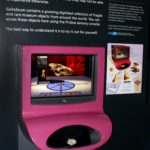Manchester Museum Digital Touch Replicas and Gallezeum
Two new 3D digital interactive experiences developed in the UK, Digital Touch Replicas and Gallezeum® were evaluated by Visually Impaired working groups in Austria, Germany and the UK; they have been found to offer new ways of accessing museum collections and encouraging participation in museums.
DTRs or digitally scanned replicas, allow access to inaccessible objects via hidden touch sensors, delivering information via audio visual multimedia as the user explores a physical replica. Gallezeum, a new digital platform, uses haptics, where the user makes a virtual tactile connection with a digitized museum object, presented with multimedia in a virtual three-dimensional environment.
Project objectives
We set out to create a viable 3D digital experience which allows access to museum objects which would normally be unavailable to the public and visually impaired visitors; as the objects would be too fragile to touch and mostly displayed behind glass.
Involvement of disabled users
At Manchester Museum the Henshaw’s Society for Blind People working group were consulted at every stage of the AMBAVIs project. The Henshaw’s working group was involved in earlier work with the development of the Gallezeum Interactive. In 2014 this work was awarded one of the 3 Innovative Practices Awards for Accessibility: Haptic and tactile museum experience from the Zero Project. The Zero Project is an initiative of the Essl Foundation, focusing on the rights of persons with disabilities globally https://zeroproject.org/practice/haptic-and-tactile-museum-experience/
Also in 2013 the work at Manchester Museum with the Gallezeum Interactive (or Probos Console as it was then known) was also shortlisted for the Museums + Heritage Innovations Award
Planning:
- The group from Henshaw’s come in for the regular handling sessions as part of Manchester Museum’s engagement for our exhibition programme. We have worked with Henshaw’s on previous iterations of the technologies (as above) and involved them from the very beginning of the AMBAVis project.
Design:
- There are several adaptations within the Gallezeum interface as well as software adaptation in the Digital Touch Replicas that relate directly to the way in which VI users interact with the technology and there advice for improvements have been incorporated; such as the grooved floor navigation in the Gallezeum Interactive and the triggering of multimedia information on the DTRs
Implementation:
Testing:
- Over the two years of the project both technologies were tested extensively with users in the UK, (at sessions at Manchester Museum and outreach at Henshaw’s Art Centre in Knaresborough) and with VI groups in Vienna (Austrian Federation of the Blind and Partially Sighted (BSVÖ) and Berlin (German Association for Blind and Visually Impaired People (DBSV e.V.) groups organized by partners and their respective National Blind Institutes
Evaluation:
- Questionnaires were used to evaluate the working group’s response to the 3D technology ease of use, potential and what they liked about them. It was found that the VI groups who had worked with us on earlier versions of the technologies in Manchester could navigate them more easily; showing that in the short term some facilitation was needed to introduce those with visual impairments to the new technologies. Information relating to impact of the 3D technologies, Economic impact and Copyright issues can be found at: http://www.ambavis.eu/downloads/
- For both technologies there were pros and cons that were assessed throughout the life- cycle of the project and improvements were made when possible and the budget allowed.
Other:
- Members of the VI group have demonstrated the device to Visitors
Innovative inclusive features
- Gallezeum – the ability to touch and interact physically with 3D digital files within the computer triggering multimedia information when the surface of the digital scanned file is touched by the user via the haptic enabled (Fingertip/VR) handle. The form of the whole object can be touched and accessed with the new handle.
- The DTR delivers information (sound, image and at times video) when an area of interest is touched as the VI user explores the object.
- Both technologies allow for the integration of multiple digital narratives on the same objects.
Both types of technologies are available to all visitors on the gallery or during outreach sessions – however you can choose features on them that assist the VI user to have a more enjoyable experience and understand the object and the associated multimedia.

